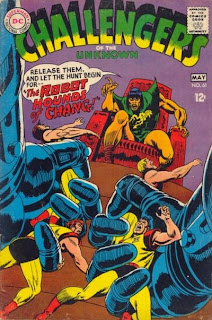 Flash #178
Flash #178 (On Sale: February 8, 1968), AKA 80 Page Giant #G-46, has a cover by
Ross Andru and
Mike Esposito featuring the
"Scarlet Speedster's Most Terrific Team-Ups!"We begin with
"Land of Golden Giants," from
Flash #120, by
John Broome, Carmine Infantino and
Joe Giella. Barry Allen and Iris West are accompanying Dr. Manners on a scientific expedition. Iris’ nephew Wally West and Gail, the scientists granddaughter, are going as well. This is an historic story in that prior to the trip Barry reveals his identity as the Flash to Wally, who is also
Kid Flash.
The expedition arrives off the coast of South America. Dr. Manners plans to prove that South America was once joined with the African continent. A nearby volcanic eruption triggers an earthquake and the expedition is badly damaged. As the group recovers they notice that the volcanic mountain is no longer anywhere to be seen.
Barry and Wally go exploring and come across a prehistoric tribe. A tribesman warns the pair of Flashes of a giant. The giant attacks and captures Flash. He is barely able to escape the giant’s grasp. Using some metal cabling that was brought on the expedition, Flash and his partner manage to tie the giant up.
Flash realizes that the expedition has been sent back through time and also learns that Dr. Manners’ theory is correct. A violent earthquake begins and the continents are about to become separated. Flash and Kid Flash help the tribesmen escape their village
(nothing like changing a little history while you're back in time!). A group of giants attack, but they are washed away by flood waters. Using their super-speed vibrations, Flash and Kid Flash are able to transport the expedition back to the present before the disaster strikes. Dr. Manners brings back a photograph that proves his theory to be correct.
Next is
"Double Danger on Earth," a reprint from
Flash #129 by
Gardner Fox, Carmine Infantino and
Joe Giella. Earth-2 is imperiled by deadly radiation which was created when a comet struck the sun. The
Flash of Earth-2, Jay Garrick, desperately seeks a method to remove the radiation as the radiation is killing all life on Earth. A meteorite in the Arizona desert is absorbing the radiation, but it has mysteriously disappeared. Garrick theorizes that an identical meteorite should be on Earth-1. He travels between Earths to bring back the meteorite and save his world.
On Earth-1, Barry Allen and Iris West are attending a costume party for charity. The charity proceeds are stolen by Captain Cold. The Trickster, who also has come to steal the money, steps in and takes the loot from Cold. Garrick arrives on the scene looking for Barry and spots the thieves. Barry, seeing the battle, races to help in his Flash identity. Confronted by two Flashes, the villains team-up to escape with the money.
With the crooks out of sight, Jay explains to Barry the problem on his world. Barry makes arrangements for Jay to acquire the meteorite. Using his powers Jay is able to dig it up and break it into smaller pieces.
Before transporting the fragments back to his world, Jay agrees to help Barry catch the crooks. They bait a trap for the pair which reveals that valuable diamonds were found in the meteorite. Captain Cold and the Trickster show up to steal the diamonds, and the Flashes are able to follow them back to their hide-out and capture them.
With the villains taken out of action, Jay transports the fragments back to Earth-2. The meteorite dust removes the radiation and saves the world. The dust is also synthesized so when the same disaster strikes Earth-1, the synthetic dust is able to protect that world as well.
This story is historic in that a flashback sequence briefly relates the first story of All
-Star Comics #57. The Justice Society of America appear in the flashback and would make their first non-flashback modern appearance later in
Flash #137.The final story is
"Captives of the Cosmic Ray," a reprint from
Flash #131 produced by
John Broome, Carmine Infantino and
Joe Giella. While Barry Allen is vacationing in Coast City, an alien ship flies over the area. Barry and his friend Hal Jordan chase the ship as Flash and Green Lantern. A yellow beam strikes Flash and takes him aboard the ship. Green Lantern follows it to an unknown planet. The two heroes are attacked by the planet itself but manage to escape and return to Earth.
When they arrive on Earth, our heroes discover the planet has been invaded by the Myrmitons. The alien being hold the world hostage unless the heroes surrender. Flash and Green Lantern agree to give up their powers, but Flash devises a trick to fool the invaders.
The Myrmitons realize that they have been tricked, but the heroes have already made their way to the base of the villains. Flash disables the machines that were threatening the population while Green Lantern captures the aliens. With the invasion thwarted, our heroes return to their civilian identities.
Edited by Julius Schwartz.
 Strange Adventures #211 (On Sale: February 29, 1968) has a nice dramatic cover by Neal Adams.
Strange Adventures #211 (On Sale: February 29, 1968) has a nice dramatic cover by Neal Adams.

































